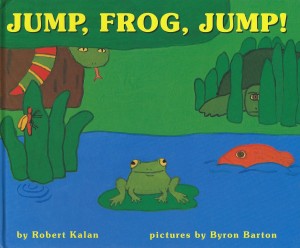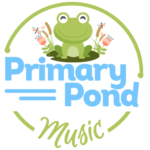One of my favourite go-to resources is Artie Almeida’s “Mallet Madness” book. I love having quality lessons prepared to go when I’m looking for inspiration… especially at this time of the year! We have 6 weeks of school left, and the kids are driving me buggy! One of my favourite things is that children’s literature (and good quality children’s literature!) is included in this resource. Funny thing, though – even though children’s literature was a passion of mine during university, I had never taught any of the literature lessons in this book! Aghast, I promptly ordered a bunch of the books from the list in Mallet Madness.
The books arrived earlier this week, and even though I had planned a Peter and the Wolf lesson for my grade twos, I knew I had to use the “Jump, Frog, Jump!” lesson instead. The grade twos have been doing animal research activities in their class, and I thought this would be a great chance to tie in some music to their science lessons (yay for cross-curricular!).
I followed Artie’s lesson plan pretty closely, but then started adding a few of my own touches. This is one thing I LOVE about teaching with the Orff process: it allows me a chance to be creative and explore new ideas; I get so excited when inspiration hits. And hit it did!
Here are a few things I added to the lesson from Mallet Madness:
- After clapping on ‘Jump, frog, jump,’ I got out my three frog guiros (wishing I had a full class set of them!) I had the kids sitting in a circle and distributed the guiros around the circle. Every time we said, “jump, frog, jump!” three children playe
 d the rhythm on guiros, then passed it to the next student.
d the rhythm on guiros, then passed it to the next student. - For the movement activity, we played an elimination game. Since the kids have been researching animals, we talked about predators and how animals protect themselves. We decided that frogs are green so they can hide in the grass and not be seen, but if they moved, they could be seen (they might have had a wee bit of prompting on that one!) If the children moved when they weren’t supposed to, they were seen by whatever predator was on that particular page of the book and were eaten (had to go stand along the wall). They loved it!
- I also told the kids that the big idea for the lesson was that musicians know when to play and when not to play. Being near the end of the school year, Spring fever has set in and the kids are having difficulty keeping their instruments quiet when I’m talking.
One thing I really loved about this lesson is that the kids were able to transfer the idea of jumping frogs to the mallets; their mallet technique in this lesson was great! I really emphasized letting the mallets bounce like a frog and it worked. We ended the lesson with “Frog in the Middle,” singing and playing a bordun.
While the kids were doing the mallet activity, inspiration hit! Earlier in the day, I was teaching “Bought Me a Cat” to my kinders in preparation for playing a different instrument for each animal (a lesson I teach every year). I realized that I could do the same thing with this book! Next week, I plan to have the kids work on adding non-pitched percussion instruments, then putting together a mini performance.
Have you used this book in your classroom? What activities have you done with it? What other frog-themed music activities are popular with your kids? Leave your ideas in the comment section 🙂

 Chrome Music Labs
Chrome Music Labs  How I Got a Free Picture Book for my Classroom!
How I Got a Free Picture Book for my Classroom!
So, what do you think ?